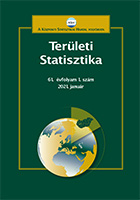A hazai települési jövedelemegyenlőtlenségek sajátosságai a földrajzi közelhatások alapján, 2012–2019
Characteristics of settlement income inequality in Hungary by geographical proximity, 2012–2019
Author(s): Zoltán EgriSubject(s): Social Sciences, Economy, Geography, Regional studies
Published by: Központi Statisztikai Hivatal
Keywords: income inequalities; geographical proximity; spatial autocorrelation; spatial and LISA Markov chain
Summary/Abstract: The main question the author seeks to answer is how local (settlement level) income inequalities are shaped by the effects arising from different geographical proximity. The central hypothesis of the research is that spatial proximity effects typically affect not only static but also dynamic income positions. It is further hypothesised that income mobility resulting from proximity effects drives individual settlements towards club formation, with significant spatial concentration processes underlying these clubs and showing temporal and spatial variation. The paper describes the spatial organizing phenomenon of geographic proximity and the implicit and explicit spatial correlations that have appeared and been shown in domestic income processes. The analyses answer the research hypotheses and questions with the ETSDA and ESTDA methods used in spatial econometrics. The results show that the evolution of settlement income inequality cannot be interpreted without knowledge of geographical proximity. Spatial proximity has a crucial influence on the chances of settlements to stagnate, catch up and fall behind. The neighbourhood microenvironment suggests that settlements form spatially significant income clubs, with real processes behind them. The evolution of spatial clubs over time is characterised by both stability and mobility, with phenomena before and after the 2008 global economic crisis being clearly distinguishable.
Journal: Területi Statisztika
- Issue Year: 62/2022
- Issue No: 06
- Page Range: 625-662
- Page Count: 38
- Language: Hungarian

